August 18. LAKE MANYARA TO SERENGETI NP - "Northern Safari Circuit - Day Two" We had a long drive ahead of us to reach the Serengeti NP, passing along the rim of the Ngorongoro crater en route. The road gradually left the Great Rift Valley as it headed up towards the crater rim. A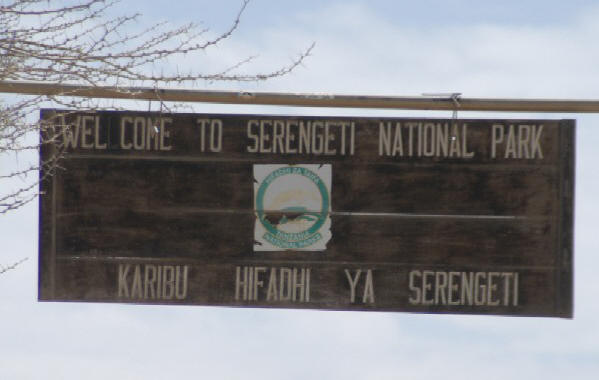 couple of look out points hung off the edge of the road, overlooking the valley. When we didn't stop Babsi asked Sisti if we could take a quick look. He snapped back that we would stop on our way back, on the fourth day. We kept going but at a slow pace. Naturally we were all eager to get to the Serengeti as soon as possible but it was Babsi the piped up again and asked if we could pick up the pace. Sisti snapped back that he was doing what was best for us, so i.e. "be quiet". It was pretty rude. He may have been experienced and more or less did what he should but he didn't exactly sugar coat it. Finally we stopped at the entrance to the Crater National Park. We looked at the little visitor's center while Sisti organized the transit permit. couple of look out points hung off the edge of the road, overlooking the valley. When we didn't stop Babsi asked Sisti if we could take a quick look. He snapped back that we would stop on our way back, on the fourth day. We kept going but at a slow pace. Naturally we were all eager to get to the Serengeti as soon as possible but it was Babsi the piped up again and asked if we could pick up the pace. Sisti snapped back that he was doing what was best for us, so i.e. "be quiet". It was pretty rude. He may have been experienced and more or less did what he should but he didn't exactly sugar coat it. Finally we stopped at the entrance to the Crater National Park. We looked at the little visitor's center while Sisti organized the transit permit.
We made one stop along the rim to view the crater before continuing on our way to the Serengeti National Park. It was an awesome sight, the vast open space spreading out across the bottom of the enormous crater floor, punctuated by a large white soda lake and a cluster of forest. The barren landscape gave way to heavier vegetation up the slopes of the crater. It was just a quick glimpse of what we had in store for us on the fourth day of our safari.
The road pulled away from the crater's edge but kept winding along the rim, tarmac eventually giving way to dirt. A couple of posh looking hotels were tucked in vegetation and overhung the crater.  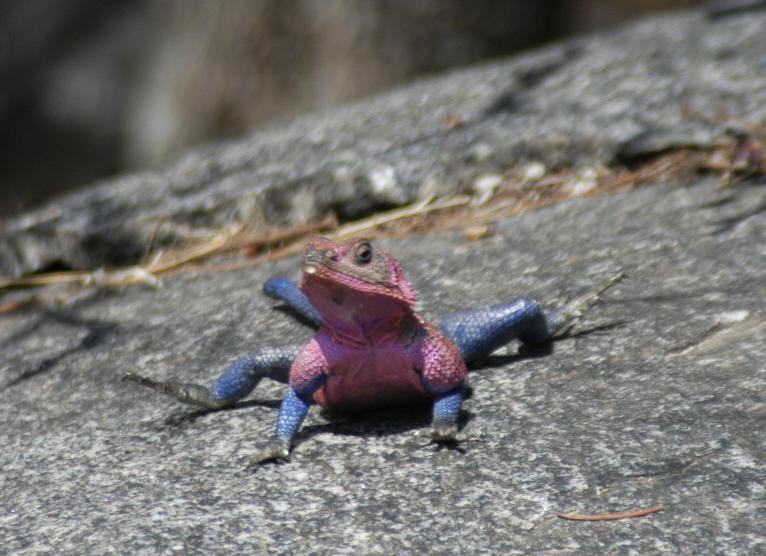 That was the expensive way to travel. When we asked who stayed at these pricey hotels Sisti said there were many American travelers staying there. We asked where else do the people come from. He paused and said it was mostly Americans. Americans for where I wondered?! That was the expensive way to travel. When we asked who stayed at these pricey hotels Sisti said there were many American travelers staying there. We asked where else do the people come from. He paused and said it was mostly Americans. Americans for where I wondered?!
As we dropped down the far side of the crater rim the dirt road descended around a small Maasai village. It was a traditional cluster of thatch-roofed homes and even from the road their bright red shukas (blankets worn over their shoulders) could be easily seen against the dry brown landscape. The Serengeti and Ngorongoro are Maasai homeland, stretching all of the way north into Kenya's where the park bears their namesake, the Masai Mara National Reserve. Regulating their ongoing livelihood within these areas has been an ongoing struggle between the Maasai and the governments. Maasai are traditionally a warrior tribe and hunting for their food is an important part of their identity. We didn't pass another Maasai village so their numbers within the park areas must not be very large.
As the road leveled out we were looking out over the seemingly endless savanna that defines what many people think of as Africa. Countless documentaries on the wildlife of the Serengeti, where animals are so much easier to photograph, have made this landscape seem almost infinite. We pulled off of the road for a lunch break in what felt like the middle of nowhere but the obtrusive little birds that came begging for food told it was a well used picnic spot. Not far from us but out of view was the famous Olduvai Gorge, where 3.6 million-year-old hominid footprints were found at Laetoli in the 1970's by archeologist Mary Leakey. While we didn't have time to visit the small museum, our proximity still made us ponder Africa's rich archeological history. 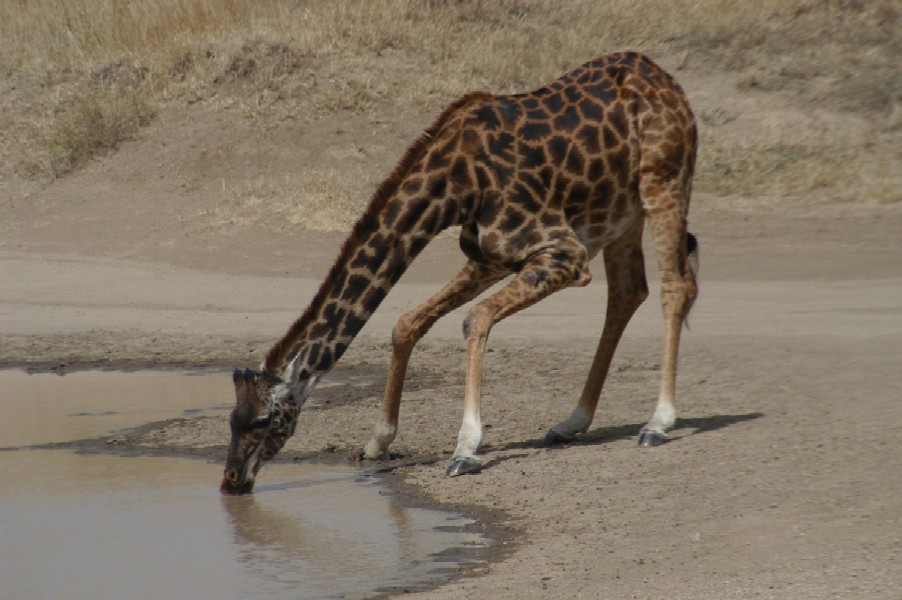 Mitochondrial DNA (mDNA) research indicates that we all evolved from one woman in Africa, millions of years ago. Mitochondrial DNA (mDNA) research indicates that we all evolved from one woman in Africa, millions of years ago.
Our long day of driving was slowly starting to reward us with more than just striking landscape. We saw a few ostrich, then a hand full of Thompson's gazelle and then some Grant's gazelle, differentiated by a black stripe that runs along the sides of the Thompon's belly. Eventually we passed under a simple gate which represented the demarcation point between the Crater NP and the Serengeti NP. The actual park entrance was still a bit farther. Sisti was driving faster now but still stopped occasionally for us to look at the odd gazelle. When we reached the park entrance we had a good half hour to stretch our legs while he organized another permit. From the time we entered we had 24 hours inside the Serengeti National Park. That is why Sisti didn't want to arrive too soon. The animals aren't very active in midday so he wanted us to have all evening and all of the following morning before we had to head back to the Crater again. We took a short hike up the nearby nature trail while we waited. At the top of a small kopje (rock outcrop) we could see across the wide-open Serengeti plains. An agama lizard, with its pink and blue body, came out for a photo shoot, resting on a large rock in front of us. It was striking color for a animal that lived in such a colorless landscape. Back down near the park headquarters there were numerous little birds with colorful iridescent wings were flirting for food from the tourists.
Back on the road we continued towards the center of the park where we would set up camp for the night. On either side of us the plains stretched as far as the eye could see. We paused 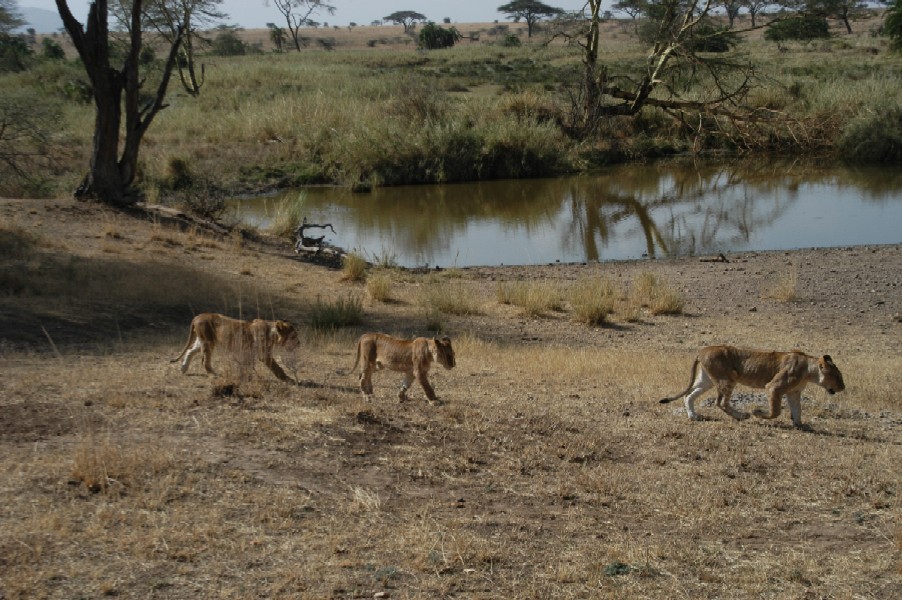  to see more gazelles. Spotting something to our left Sisti detoured off of the main road towards the towering figures of two giraffe that were standing on the top of a small hill. As we approached the hill we could see that it was hiding a large watering hole. One giraffe was moving towards the hole while the second stood up on the ridge and kept watch. Sisti commented on how it was unusual to see two giraffe in the middle of the plains during midday. They were visible from miles away. We stopped the truck near the watering hole and watched as the giraffe awkwardly braced itself with its long legs, bent its knees, and stretched its head for a drink. It was an odd sightA second safari vehicle rolled in behind us and stopped as well. The increasing number of observers seemed to make them uneasy so the drinking giraffe cautiously moved past us and up the hill to the second. They paused for a moment to consider their options before gliding down the far side of the hill. I felt a tinge of guilt that our presence had interrupted their quest for water. to see more gazelles. Spotting something to our left Sisti detoured off of the main road towards the towering figures of two giraffe that were standing on the top of a small hill. As we approached the hill we could see that it was hiding a large watering hole. One giraffe was moving towards the hole while the second stood up on the ridge and kept watch. Sisti commented on how it was unusual to see two giraffe in the middle of the plains during midday. They were visible from miles away. We stopped the truck near the watering hole and watched as the giraffe awkwardly braced itself with its long legs, bent its knees, and stretched its head for a drink. It was an odd sightA second safari vehicle rolled in behind us and stopped as well. The increasing number of observers seemed to make them uneasy so the drinking giraffe cautiously moved past us and up the hill to the second. They paused for a moment to consider their options before gliding down the far side of the hill. I felt a tinge of guilt that our presence had interrupted their quest for water.
Back on the main road we saw a massive eagle perched nearby and stopped just as it took flight. Farther beyond there was a kopje and through our telephoto lenses we could vaguely recognized the heads of several lions keeping watch from a large rock. Perhaps they were eyeing the giraffe. As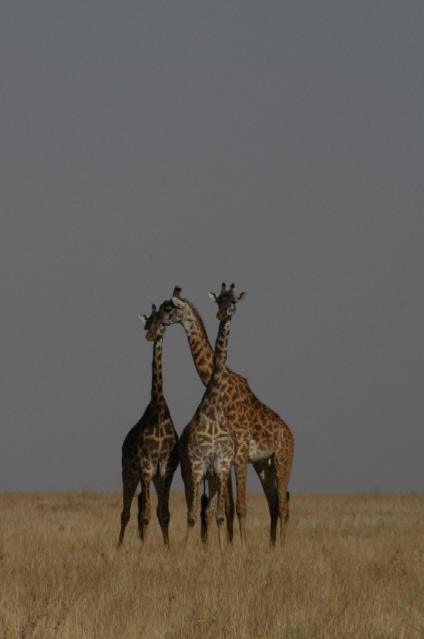 more trees started to dot the landscape we encountered more giraffe, this time nibbling away at prickly bushes and too preoccupied to be daunted by our trucks. Behind the giraffe a handful of Topi gave us suspicious looks, their eyes hidden amidst their dark faces, big ears perked. On the other side of the road a population of hippos were floating in a pond, keeping the lower part of their head hidden under the water but completely given away by their bulbous bodies. Then something started to happen. Safari vehicles began to converge on one another and Sisti jumped into action to see what was happening. Lions, maybe... more trees started to dot the landscape we encountered more giraffe, this time nibbling away at prickly bushes and too preoccupied to be daunted by our trucks. Behind the giraffe a handful of Topi gave us suspicious looks, their eyes hidden amidst their dark faces, big ears perked. On the other side of the road a population of hippos were floating in a pond, keeping the lower part of their head hidden under the water but completely given away by their bulbous bodies. Then something started to happen. Safari vehicles began to converge on one another and Sisti jumped into action to see what was happening. Lions, maybe...
As we pulled up the road, not far from a river, we spotted a small lioness trot casually past our truck. Under the shade of a large Acacia tree there was a large group lions taking rest, many had faint spots on their fur indicating they were still cubs. One by one they jogged past the growing row of vehicles parked on the road. They seemed almost oblivious to us as they carried out their covert operation, moving swiftly through the open area, pausing behind another tree and then disappearing in some tall grass. Almost as entertaining as the lions were all of the cars of tourist trying to take photos. Lined up along the road there were cars stretched in both directions. I spotted one guy sitting on top of his safari roof, shirt off, a animal tooth necklace dangling down his chest, a  large beaded Maasai bracelet, a safari hat and a two foot long telephone lens. Sisti maneuvered the truck forward to get a better look at where the lions were now positioned. Across the street stood three perfected erect giraffe that had positioned themselves into a kind of defensive triangle to keep watch in all directions. We could see the heads of the lions peeking out above the grass, looking towards the giraffe. The giraffe were looking right back. It was a standoff. After observing this defensive gridlock for a while we finally moved on in search of other viewing. large beaded Maasai bracelet, a safari hat and a two foot long telephone lens. Sisti maneuvered the truck forward to get a better look at where the lions were now positioned. Across the street stood three perfected erect giraffe that had positioned themselves into a kind of defensive triangle to keep watch in all directions. We could see the heads of the lions peeking out above the grass, looking towards the giraffe. The giraffe were looking right back. It was a standoff. After observing this defensive gridlock for a while we finally moved on in search of other viewing.
Rounding the backside of the hippo pond we drove up the other side of the river. A small group of hippos were congregated on the shore, looking much less agile on land. An impala looked up from his meal to eye us. Then we came upon another cluster of safari vehicles that were parked to watch a herd of elephants cross the road, munching on any stray bush they encountered along the way. Another 50 yards down people were parked, waiting for a sleeping lioness to make a move. It became a predictable part of our safari drive to look for where other cars were congregated. The drivers stopped as they passed each other, rolling down their windows to exchange notes on where to see what. Sometimes, however, it turned out to be just a lemming effect. Someone thought they saw something, stopped, and before they confirm or deny their suspicions there were already other trucks gathering around.
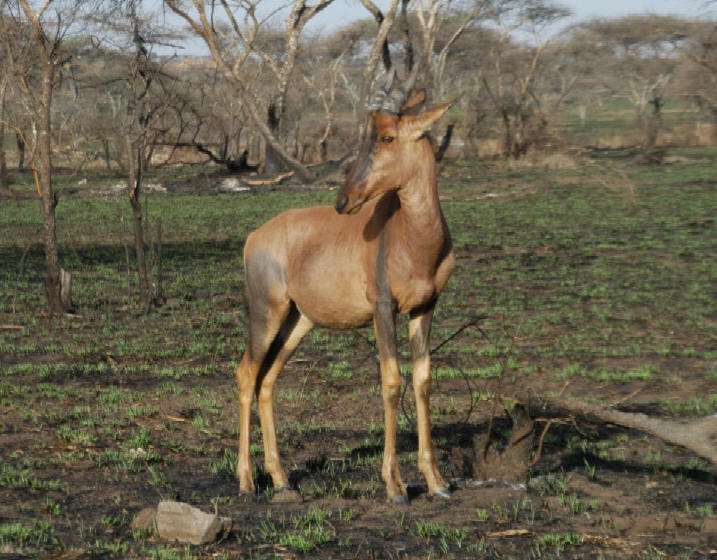  As the after-noon turned into dusk we wound our way through the maze of roads in the middle of the park, where the campgrounds were tucked away. In this area of denser foliage and green grass there were larger herds of antelopes and buffalo gnawing away on dinner. Our campground was already filling fast when we arrived, the competition for kitchen space looked especially fierce. By kitchen I mean a covered area with a row of fire pits. Sisti looked like he was ready to call it a day when I asked if were we going to see the sunset. It had been on our itinerary and it was just moments away. We only had one night inside the Serengeti and it seemed like seeing the sunset over this incredible landscape was not something to miss. He rallied and we piled back in the truck, leaving Bernard to get dinner under way. We didn't need to head very far before we started seeing the wildlife again. Actually the campgrounds were completely open so were going to be camping amongst the wildlife. The truck was rolling along at a slow pace when we spotted something under a tree in the distance. Another lion we thought. We stopped, waited, and watched. Eventually one of two animals started to move towards and we soon recognized it as a spotted hyena with its dog-like face, spotted coat, and hunched back. There were no other trucks around so the As the after-noon turned into dusk we wound our way through the maze of roads in the middle of the park, where the campgrounds were tucked away. In this area of denser foliage and green grass there were larger herds of antelopes and buffalo gnawing away on dinner. Our campground was already filling fast when we arrived, the competition for kitchen space looked especially fierce. By kitchen I mean a covered area with a row of fire pits. Sisti looked like he was ready to call it a day when I asked if were we going to see the sunset. It had been on our itinerary and it was just moments away. We only had one night inside the Serengeti and it seemed like seeing the sunset over this incredible landscape was not something to miss. He rallied and we piled back in the truck, leaving Bernard to get dinner under way. We didn't need to head very far before we started seeing the wildlife again. Actually the campgrounds were completely open so were going to be camping amongst the wildlife. The truck was rolling along at a slow pace when we spotted something under a tree in the distance. Another lion we thought. We stopped, waited, and watched. Eventually one of two animals started to move towards and we soon recognized it as a spotted hyena with its dog-like face, spotted coat, and hunched back. There were no other trucks around so the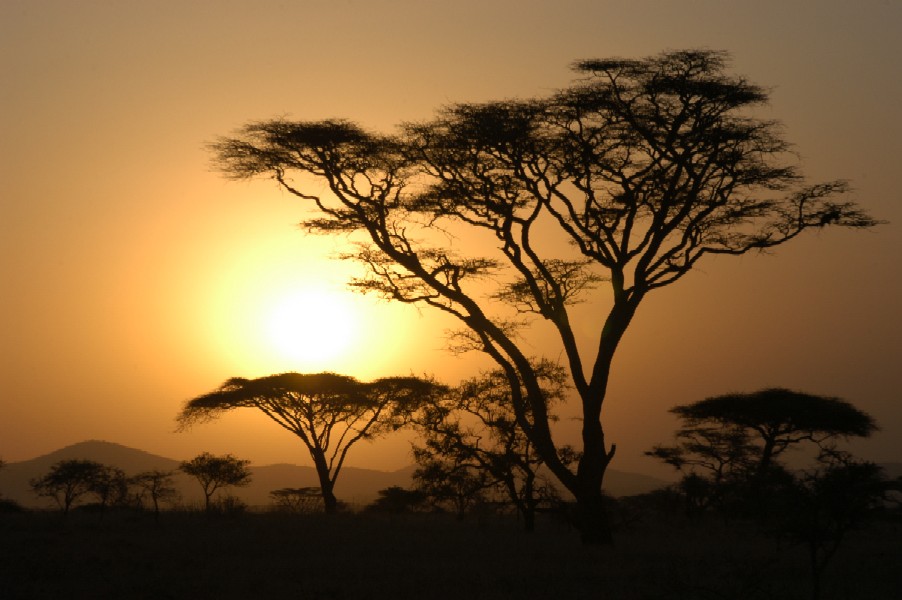 hyena proceeded to move in its planned direction, crossed the road, and paused to look back at us, its face lit by the setting sun. It made a turn and walked back along the side of our truck and walked down the road. hyena proceeded to move in its planned direction, crossed the road, and paused to look back at us, its face lit by the setting sun. It made a turn and walked back along the side of our truck and walked down the road.
With the sunlight fading fast we found a spot in front some dramatic acacia trees where we could watch the sun set through their lacy branches. It was perfect.
By the time we returned to camp Bernard had our tents set up and dinner was not far behind. I am not sure how he managed to get it all done so fast. |

